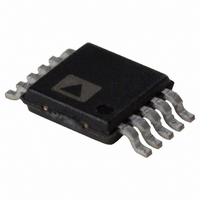AD7687BRMZ Analog Devices Inc, AD7687BRMZ Datasheet - Page 16

AD7687BRMZ
Manufacturer Part Number
AD7687BRMZ
Description
IC ADC 16BIT 250KSPS 10-MSOP
Manufacturer
Analog Devices Inc
Series
PulSAR®r
Datasheet
1.AD7687BCPZRL7.pdf
(28 pages)
Specifications of AD7687BRMZ
Data Interface
DSP, MICROWIRE™, QSPI™, Serial, SPI™
Number Of Bits
16
Sampling Rate (per Second)
250k
Number Of Converters
1
Power Dissipation (max)
12.5mW
Voltage Supply Source
Single Supply
Operating Temperature
-40°C ~ 85°C
Mounting Type
Surface Mount
Package / Case
10-TFSOP (0.118", 3.00mm Width)
Resolution (bits)
16bit
Sampling Rate
250kSPS
Input Channel Type
Differential
Supply Voltage Range - Analog
2.3V To 5.5V
Supply Voltage Range - Digital
1.8V To 5.5V
Lead Free Status / RoHS Status
Lead free / RoHS Compliant
For Use With
EVAL-AD7687CBZ - BOARD EVALUATION FOR AD7687
Lead Free Status / RoHS Status
Lead free / RoHS Compliant, Lead free / RoHS Compliant
Available stocks
Company
Part Number
Manufacturer
Quantity
Price
Company:
Part Number:
AD7687BRMZ
Manufacturer:
ADI
Quantity:
1 000
Part Number:
AD7687BRMZ
Manufacturer:
ADI/亚德诺
Quantity:
20 000
Part Number:
AD7687BRMZ-REEL
Manufacturer:
ADI/亚德诺
Quantity:
20 000
Part Number:
AD7687BRMZ-RL7
Manufacturer:
ADI/亚德诺
Quantity:
20 000
Company:
Part Number:
AD7687BRMZRL7
Manufacturer:
ADI
Quantity:
1 000
Part Number:
AD7687BRMZRL7
Manufacturer:
ADI/亚德诺
Quantity:
20 000
AD7687
DRIVER AMPLIFIER CHOICE
Although the AD7687 is easy to drive, the driver amplifier
needs to meet the following requirements:
•
•
•
Table 10. Recommended Driver Amplifiers.
Amplifier
AD8021
AD8022
OP184
AD8605, AD8615
AD8519
AD8031
The noise generated by the driver amplifier needs to be
kept as low as possible in order to preserve the SNR and
transition noise performance of the AD7687. Note that
the AD7687 has a noise much lower than most of the other
16-bit ADCs and, therefore, can be driven by a noisier op
amp while preserving the same or better system perform-
ance. The noise coming from the driver is filtered by the
AD7687 analog input circuit 1-pole, low-pass filter made
by R
Because the typical noise of the AD7687 is 53 μV rms,
the SNR degradation due to the amplifier is
where:
f
(2 MHz) or the cutoff frequency of the input filter, if
one is used.
N is the noise gain of the amplifier (for example, +1 in
buffer configuration).
e
in nV/√Hz.
For ac applications, the driver should have a THD
performance commensurate with the AD7687. Figure 17
shows the THD vs. frequency that the driver should
exceed.
For multichannel multiplexed applications, the driver
amplifier and the AD7687 analog input circuit must settle a
full-scale step onto the capacitor array at a 16-bit level
(0.0015%, 15 ppm). In the amplifier’s data sheet, settling at
0.1% to 0.01% is more commonly specified. This could
differ significantly from the settling time at a 16-bit level
and should be verified prior to driver selection.
–3dB
N
is the equivalent input noise voltage of the op amp,
is the input bandwidth in MHz of the AD7687
IN
SNR
and C
LOSS
IN
=
or by the external filter, if one is used.
20log
Typical Application
Very low noise and high frequency
Low noise and high frequency
Low power, low noise, and low frequency
5 V single-supply, low power
Small, low power and low frequency
High frequency and low power
⎛
⎜
⎜
⎜ ⎜
⎝
53
2
+
π
2
f
−
53
3dB
(
2
Ne
N
)
2
⎞
⎟
⎟
⎟ ⎟
⎠
Rev. A | Page 16 of 28
SINGLE-TO-DIFFERENTIAL DRIVER
For applications using a single-ended analog signal, either
bipolar or unipolar, a single-ended-to-differential driver
allows for a differential input into the part (see Figure 31 for
the schematic). When provided a single-ended input signal,
this configuration produces a differential ±V
at V
ANALOG INPUT
VOLTAGE REFERENCE INPUT
The AD7687 voltage reference input, REF, has a dynamic input
impedance and should therefore be driven by a low impedance
source with efficient decoupling between the REF and GND
pins, as explained in the Layout section.
When REF is driven by a very low impedance source, for
example, a reference buffer using the AD8031 or the AD8605, a
10 μF (X5R, 0805 size) ceramic chip capacitor is appropriate for
optimum performance.
If an unbuffered reference voltage is used, the decoupling value
depends on the reference used. For instance, a 22 μF (X5R,
1206 size) ceramic chip capacitor is appropriate for optimum
performance using a low temperature drift ADR43x reference.
If desired, smaller reference decoupling capacitor values down
to 2.2 μF can be used with a minimal impact on performance,
especially DNL.
Regardless, there is no need for an additional lower value
ceramic decoupling capacitor (for example, 100 nF) between the
REF and GND pins.
POWER SUPPLY
The AD7687 is specified over a wide operating range of 2.3 V to
5.5 V. Unlike other low voltage converters, it has a low enough
noise to design a 16-bit resolution system with low supply and
respectable performance. It uses two power supply pins: a core
supply VDD and a digital input/output interface supply VIO.
VIO allows direct interface with any logic between 1.8 V and
VDD. To reduce the supplies needed, the VIO and VDD can be
tied together. The AD7687 is independent of power supply
sequencing between VIO and VDD. Additionally, it is very
(±10V, ±5V, ..)
REF
/2.
VREF
Figure 31. Single-Ended-to-Differential Driver Circuit
VREF
10kΩ
10kΩ
100nF
590Ω
U1
100nF
590Ω
590Ω
U2
VREF
REF
10μF
with midscale
IN+
IN–
AD7687
REF













